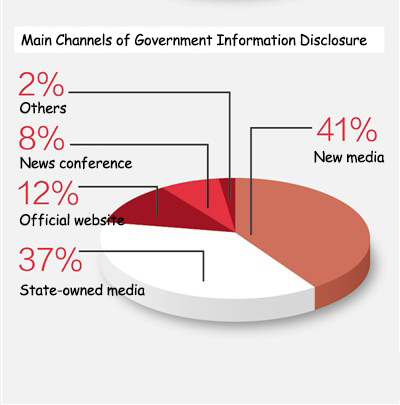E-government becoming common feature of daily life

According to the report 2016 Evaluation of China’s Official Response to National Public Opinion of Government Affairs issued by the Think Tank of People’s Daily Online, e-government platforms such as new media, State-owned media and the official website constitute the main channels of China’s government information disclosure.
According to the 2016 China Internet Network Development Statistic Report issued by China Internet Network Information Center on Jan. 22, the users of e-government services in China totaled 239 million, accounting for 32.7 percent of all Internet users.
Now that it has become widespread, e-government is an important way for China to improve its governance capacity.
Instant services
After more than a year of preparations and trials, the e-government service network of Jiangsu Province was made available to the public at the beginning of this year. Since then, all the government services of Jiangsu Province, including inquiry, payment and enrollment have been available on one website.
Administrative management was one of the earliest fields in which informatization was implemented in China. After years of progress, e-government management has made great strides.
The government’s service mode has transformed to make it possible for the public to enjoy effective online service anytime and anywhere on a demand basis without having to go to relevant departments or agencies for in-person consultation.
Since last year, China’s central government and ministries have issued a series of documents and regulations on fostering the information system of e-government by means of Internet Plus, cloud computing and the Internet of Things. The executive meetings of the State Council held in fall last year passed the decision to strengthen online platforms, such as official websites, and to enlarge the coverage and influence of e-government information by fully utilizing the Omnimedia.
The e-government platform of China has extended beyond government Web portals and microblogs to WeChat and other forms of social media, progressing in a more mobile, instant and transparent direction.
Dialogue with the premier
“Hello! I am an ordinary worker who works in Shanghai. My father has retired from the workplace and my mother worked on the farm in the past. Both of them have moved from my hometown in Henan Province to Shanghai and are now living together with me. My mother is a member of the new rural cooperative medical system of our hometown but still is unable to enjoy the medical insurance because she is now out of the hometown. Whenever there is a severe disease, our family faces grave economic pressure. Even if we could submit an expense account and apply for the reimbursement when we come back to Henan Province, the procedures are far too complicated and inconvenient. I recommend that a nationwide network of medical insurance be established that could better cover the new rural cooperative medical system.”
One Internet user known by the username“Weiwei”wrote the aforementioned message in the column titled “Share Your Thoughts with Premier Li”on a website collecting the public’s suggestions to Chinese Premier Li Keqiang.
Of all the messages, one would find that medical treatment and health care are among the top concerns for many Internet users.
As of February, a total of more than 183,000 messages have been received since Dec. 20 last year, when the website opened, said Li Qi, a staff member of Chinese Central Government Net.
Li said the messages are usually classified into 40 major categories and 223 minor categories. Such information collection is helpful to guided decision-making and problem-solving.
On a single day, New Year’s Eve, as many as 3,701 messages were received, and the staff were unable to finish reading and sorting them until 10:30 p.m., Li said.
Regulations require that each of the messages needs to be processed on the same day it is received. Therefore, the team often works overtime in order to have the job done in a timely fashion. “Some of the messages would be selected as exemplary and posted onto the website. Those that have been censored will be passed to relevant departments and State Council leaders,”Li continued.
State Council App
On October last year, the State Council App launched the activity themed “About Streamlining Administration and Delegating Power: I have some words to say to the State Council,” which not only took place online but also offline in the Government Affairs Halls of more than 4,000 provinces, municipalities and counties. So far, more than 20,000 messages have been received.
The newest version of the State Council App was released on Jan. 20. As the companion of the Central Government by your side, the app continues to undergo innovation to constantly improve the effectiveness of its e-government function. Lin Yan, head of new media at the Operations Center of the Chinese Central Government Net, said e-government service needs to build upon the experience of e-commerce and the Web editors need to learn from product managers because the team is actually running the State Council App with the mentality of product managers.
The updated State Council App has two additional functions: One is English-language service, which provides foreigners with convenient consultation and the other is the Online Government Affairs Halls, which aggregates the Web search engines of central and local government departments.

 PRINT
PRINT CLOSE
CLOSE